Trump pivots towards Russia as China digs in for US trade war - By Dr. Mohamed A. Ramady, Al Arabiya
Once again, the world was waiting for the unexpected to happen and for carefully crafted international consensus and policy agreements to fly out of the window if President Trump does what he does best – keeping friends and foes alike on edge about his next moves.
The next saga to be played out will be the often delayed but now agreed Trump – Putin summit in Helsinki on 16 July. This will come after the US President attends a NATO summit and a somewhat low-key official visit to the United Kingdom.
No country will be on tenterhooks over surprise outcomes from the American – Russian summit than the British government which has been leading the charge in Europe against Russian mischief, whether real or imagined, in attempted spy assassinations to interference and encroachment on smaller European countries of NATO. A sudden rapprochement between the unpredictable American Trump and the more patient Russian President will certainly be more than a headache for many in Europe.
However, while the prospect of a thaw in American–Russian relations, like the dramatic but short of substance US-North Korean summit in Singapore might be good news to reduce global tensions between super powers and provide hope for settlement on many festering issues , a new phase of cooler American–Chinese relations is becoming more apparent with long term ramifications on trade and security . The Chinese have prepared for the current cooling in relations to turn to a freeze with trade war preparations against the United States.
To highlight the seriousness, President Xi Jinping personally presided over a meeting of China’s highest decision-making body, the Standing Committee of the Communist Party of China, in Beijing on June 21. It was the first time Xi has ever chaired a top decision-making body meeting focused on China-US relations since taking over as top leader. An equally unusual two-day meeting of the Central Conference subsequently followed that meeting on Work Relating to Foreign Affairs, which since 1989 has traditionally been held in December. There, Xi reportedly spent time again talking about US-China relations. At this meeting, President Xi called on all provinces and ministries to be prepared for a full-scale trade war with the United States.
US tariffs on $34 billion worth of Chinese goods
Why all this preparation? Chinese officials had concluded that it was inevitable the US will impose tariffs on $34 billion worth of Chinese goods on July 6, and so were taking steps to respond accordingly with tariffs of their own. To give added weight to the deliberations, the Chinese Politburo Standing Committee had also endorsed the State Council plans to take “extreme measures” in response that would restrict the expansion of new businesses by US companies in China, especially in the financial sector. The Chinese had still kept all doors open for a trade compromise in that if and when the US were to reach out for a new round of talks, China will be ready to negotiate, but that outreach has now expired after the US made its move.
In any trade war, the first line of weakness or defence is the national currency as exemplified by the near collapse of the Iranian Riyal in face of tightening US led sanctions. The Chinese were not taking any chances and senior Chinese financial officials commented on Beijing’s financial response to the looming trade threats. The widely anticipated reduction in the RRR (Reserve Requirement Ratio) on by 50 basis points is expected to release up to 500 billion yuan /RMB to the commercial banks, with another 200 billion yuan set for easing credit strains for small and micro businesses. And as borrowing costs are still high, and uncertainty over trade expected to persist, the People’s Bank of China does not rule out another two or three RRR cuts of 50 basis points each through the remainder of the year.
With trade tensions abound, officials also expect that the Chinese currency will continue to depreciate against the dollar in the short term. The Chinese Central Bank will not intervene in the foreign exchange markets, and will allow markets to determine the RMB exchange rate, while assuring that short-term currency devaluations will not lead to “massive” capital outflows. The Chinese also have another weapon to deploy against the USA in the financial markets are but are holding back for the time being. The Chinese Central Bank while refraining from increasing its holdings of US Treasury bonds, but will seek to reduce them “appropriately,” but has no intention of dumping large quantities of treasuries suddenly. This remains an option if the trade war turns nasty.
A lot at stake
The Chinese certainly feel that there is a lot at stake in standing firm this time. To this end , the June 21 session of the Politburo Standing Committee was attended by members of the Central National Security Council and the Central Financial and Economic Commission as well, as non-voting participants.
President Xi and meeting participants noted that the US regards China’s achievements in science, military and defence, trade, and other fields as damaging to America’s strategic national interests. The implication was clear: either China rolls back on these strategic areas or face more trade sanctions from the US. The Chinese noted more ominous threats from the Trump administration such as the characterization of China’s “One Belt and One Road Initiative” and cooperation with Africa as a provocation to the US-led existing world order. Above all, while President Trump encourages an “America First” and “Made in America” policy priority, the US has stated clearly it regards “Made in China 2025” as a direct threat to America’s national interests.
The outcome of all these deliberations is a sombre one as it concluded that the US has identified China as its biggest potential adversary, or perhaps even its biggest potential enemy and that the Trump – Putin summit accelerates this shift. The Chinese are noted for their patience and looking far ahead in decades while other national leaders assess geo political changes in matter of weeks or days. The Chinese probably now believe that regardless of who sits in the White House, China will face more challenges and threats from the US for the next two decades or more, and China-US relations will be even more difficult than they are now. But for now, China’s leadership sees Trump as attempting to intimidate China in hopes they “fold,” and the only counter to that they believe is a tit-for-tat response at every stage. It is in Washington’s hands whether to continue, and China, must prepare for the worst with the US. President Xi made it clear that China does not want a trade war with the US, but that the US appears to want a trade war with China, and if so, China must fight back forcefully.
It is now not only who blinks first, but also who can take the most pain. The Chinese feel that in response they must make America feel more pain, and reiterated that China would never offer concessions on anything considered to be a “core interest” – Taiwan, the South China Seas, Diaoyu Islands, the “One Belt and One Road Initiative,” and “Made in China 2025.”
A British diplomat is supposed to have noted that President Trump’s key strength of character is that he “thinks outside the box” but added that it assumed that there was a box in the first place. The new rapprochement with Russia and the looming strain in relations with China will certainly push the limit of what is in and out of these mysterious boxes.
Latest News
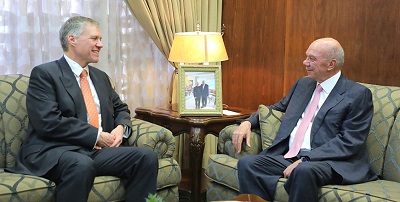 Senate president, British ambassador discuss strategic partnership, regional stability
Senate president, British ambassador discuss strategic partnership, regional stability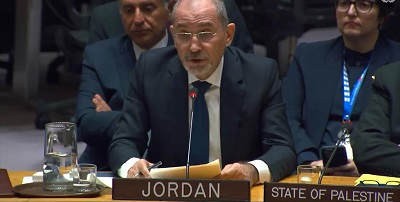 Jordan urges UN to recognise Palestine as state
Jordan urges UN to recognise Palestine as state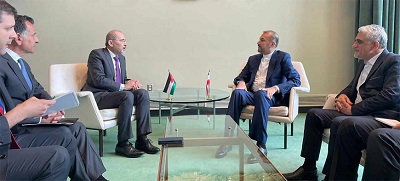 Safadi, Iranian counterpart discuss war on Gaza, regional escalation
Safadi, Iranian counterpart discuss war on Gaza, regional escalation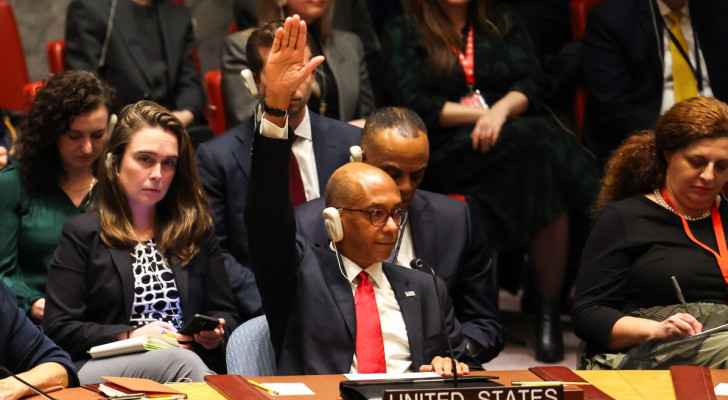 US vetoes Security Council resolution on full Palestinian UN membership
US vetoes Security Council resolution on full Palestinian UN membership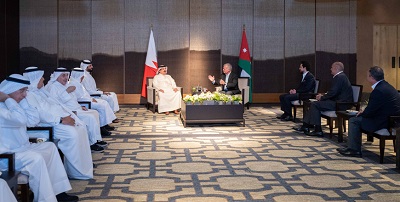 King, Bahrain monarch stress need to maintain Arab coordination
King, Bahrain monarch stress need to maintain Arab coordination
Most Read Articles
- Jordan urges UN to recognise Palestine as state
- Senate president, British ambassador discuss strategic partnership, regional stability
- JAF carries out seven more airdrops of aid into Gaza
- Safadi, Iranian counterpart discuss war on Gaza, regional escalation
- Temperatures to near 40 degree mark next week in Jordan
- US vetoes Security Council resolution on full Palestinian UN membership
- UN chief warns Mideast on brink of ‘full-scale regional conflict’
- Biden urges Congress to pass 'pivotal' Ukraine, Israel war aid
- Google fires 28 employees for protesting $1.2 billion cloud deal with “Israeli” army
- Israeli Occupation strike inside Iran responds to Tehran's provocation, reports say